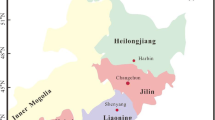Summary
Blood samples and 24-h duplicates of food were collected in the years around 1980 and then in 1990's from inhabitants of nonpolluted regions in Japan. The 1990 study is still in progress with 286 blood samples and 125 food duplicates already collected from 7 regions. A preliminary analysis is made in the present study with the data obtained from the 7 study regions where the survey was conducted in 1980 and then in 1990, to examine possible changes in dietary cadmium intake (Cd-D) and consequently cadmium levels in blood (Cd-B) during this 10 year period. The food duplicate analysis showed that Cd-D in 1980 was 47.1 μg/day (1.74):65 [GM (GSD):N] for men and 27.7 μg/day (1.75):65 for women. The counterpart values in 1990 were 29.5 μg/day (1.66):40 for men and 23.8 μg/day (1.73):85 for women; the difference between the two values for the same sex is significant (P<0.05) both in men and in women, suggesting that there occurred about 37% and 14% reduction in dietary cadmium intake during this 10 year period in men and in women, respectively. Comparison in Cd-B showed that Cd-B for men and women in 1990 were 1.79 μg/l (2.01):121 and 1.84 μg/l; (1.67):165, respectively, whereas the counterpart values in 1980 were 3.84 μg/l (1.64):123 and 3.57 μg/l (1.42):141, respectively, indicating significant (P<0.01) reduction in Cd-B in both sexes in parallel to the reduction in Cd-D. The role of rice as a major source of cadmium among Japanese population together with recent reduction in the importance is discussed; Cd in rice accounted for 72% in late 1970's, whereas it is about 35% in the present study.
Similar content being viewed by others
References
Alessio L, Odone P, Bertelli G, Foa (1983) Cadmium. In: Alessio L, Berlio A, Roi R, Boni M (eds), Human Biological Monitoring of Industrial Chemicals Series. Joint Research Centre Ispra Establishment, Ispra, Italy
Ikeda M (1991) Biological monitoring of the general population for cadmium. Presentation in International Symposium on Toxicity and Carcinogenicity of Cadmium in the Human Environment, held in Gargnano, Italy, on 25th–27th September, 1991
Ikeda M, Watanabe T, Koizumi A, Fujita H, Nakatsuka H, Kasahara M (1989) Dietary intake of lead among Japanese. Arch Environ Health 44:23–29
International Programme on Chemical Safety (1992) Environmental Health Criteria 134 Cadmium. World Health Organization, Geneva.
Ministry of Health and Welfare, the Government of Japan (1991) Nutritional status of Japanese Population, 1989. Dai-ichi Shuppan Publishers, Tokyo. pp. 41–45
Rivai IF, Koyama H, Suzuki S (1990) Cadmium content in rice and its daily intake in various countries. Bull Environ Contam Toxicol 44:910–916
Vahter M (ed) (1982) Assessment of human exposure to lead and cadmium though biological monitoring. National Swedish Institute of Environmental Medicine and Department of Environmental Hygiene, Karolinska Institute, Stockholm, pp 23–26
Vahter M, Slorach S (1990) Exposure Monitoring of Lead and Cadmium; an International Pilot Study within the WHO/UNEP Human Exposure Assessment Location (HEAL) Programme, GEMS, UNEP/WHO, Nairobi
Watanabe T, Koizumi A, Fujita H, Fujimoto H, Ishimori A and Ikeda M (1982) Effects of aging and smoking on the cadmium levels in the blood of inhabitants in non-polluted areas. Tohoku J Exp Med 138:443–444
Watanabe T, Koizumi A, Kumai M, Fujita H and Ikeda M (1983) Cadmium levels in the blood of inhabitants in nonpolluted areas in Japan with special references to aging and smoking. Environ Res 31:472–483
Watanabe T, Koizumi A, Fujita H, Kumai M and Ikeda M (1984) Role of rice in dietary cadmium intake of farming population with no known man-made pollution in Japan. Tohoku J Exp Med 144:83–90
Watanabe T, Koizumi A, Fujita H, Kumai M and Ikeda M (1985) Dietary cadmium intake of farmers in nonpolluted areas in Japan, and the relation with blood cadmium levels. Environ Res 37:33–43
Watanabe T, Cha CW, Song DB and Ikeda M (1987) Pb and Cd levels among Korean populations. Bull Environ Contain Toxicol 38:189–195
Watanabe T, Nakatsuka H and Ikeda M (1989a) Cadmium and lead contents in rice available in various areas of Asia. Sci Total Environ 80:175–184
Watanabe T, Qu J-B, Jin C, Liu Y-T, Yin S-N, Nakatsuka H, Seiji K, Inoue O and Ikeda M (1989b) Blood cadmium levels in populations of 3 Chinese cities. Toxicol Lett 47:145–153
Watanabe T, Nakatsuka H, Seiji K, Inoue O, Cho K-S, Lee K-M, Lcc BK, Lee S-H and Ikeda M (1989c) Blood cadmium levels in the population of Masan, Korea, and Miyagi, Japan; an inter-regional comparison. Toxicol Lett 47:155–163
Watanabe T, Nakatsuka H, Satoh H, Yamamoto R and Ikeda M (1992) Reduced dietary cadmium intake in past 12 years in a rural areas in Japan. Sci Total Environ 119:43–50
Author information
Authors and Affiliations
Rights and permissions
About this article
Cite this article
Watanabe, T., Iwani, O., Shimbo, S. et al. Reduction in cadmium in blood and dietary intake among general populations in Japan. Int. Arch Occup Environ Heath 65 (Suppl 1), S205–S208 (1993). https://doi.org/10.1007/BF00381342
Issue Date:
DOI: https://doi.org/10.1007/BF00381342




